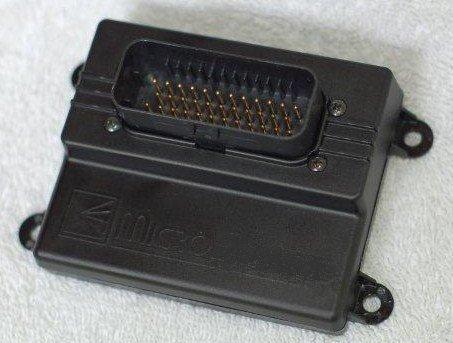
Click here for MegaSquirt® MegaManual™ Information, Guides, and Links
MicroTCU™ - QuickStart Guide


Click here for MegaSquirt® MegaManual™ Information, Guides, and Links MicroTCU™ - QuickStart Guide |

|
Your microTCU™ transmission controller has some hardware differences compared to a GPIO based controller. These differences depend to some degree on how the GPIO board is built. This document summarizes the differences and similarities between the microTCU™ controller and MShift™/GPIO controller with a standard build.
microTCU™ Pin | Use | Notes | Equivalent GPIO Pin |
| 1 | V12_RAW | Power in. | 1 |
| 2 | VSS+ | 2 | |
| 3 | BRK | Brake input (set active high or active low in software). | 3 |
| 4 | Paddle DOWN | Manual downshift button (ground to shift). | 4 |
| 5 | Input4 | Can be used as 2WD/4WD - table switch. | 5 |
| 6 | Input2 | 6 | |
| 7 | LED2 | 7 | |
| 8 | LED3 | 8 | |
| 9 | LED4 | 9 | |
| 10 | LED1 | 10 | |
| 11 | Spare Port 1 | 11 | |
| 12 | Output4/Spare Port 2 | 12 | |
| 13 | CANH | 13 | |
| 14 | ISS+ | 14 | |
| 15 | Paddle UP | Manual upshift button (ground to shift). | 15 |
| 16 | CANL | 16 | |
| 17 | BOOTL | Bootloader. Ground while cycling power to load new code. | Separate header for bootloader on GPIO board, pin #17 is a sensor ground on the GPIO board. |
| 18 | ISS- | Input shaft sensor ground for MAX9926. | No ISS- on GPIO board. Pin #18 is a ground on the GPIO board. |
| 19 | GND | 19 | |
| 20 | GND | 20 | |
| 21 | Serial Rx | 21 | |
| 22 | Serial Tx | 22 | |
| 23 | Output1 | 23 | |
| 24 | Load | 24 | |
| 25 | Input 3 | 25 | |
| 26 | Input 1 | 26 | |
| 27 | Line Pressure Input | 27 | |
| 28 | VSS- | Vehicle speed sensor ground for MAX9926. | VSS- goes to pin #17 on GPIO board. Pin #28 is 5Vref on the GPIO board. |
| 29 | 1AMP | One amp constant current supply for pressure control solenoid. | Not available on the GPIO board. Pin #29 on the GPIO board is connected to VR4, which is not used on the standard GPIO build. |
| 30 | Temperature Input | 30 | |
| 31 | Speedo Out | Can be used as spare port 0. Requires external transistor for devices capable of flowing more than 200 milliamps. | 31 |
| 32 | TCC | 32 | |
| 33 | PC | 33 | |
| 34 | Output 3 | 34 | |
| 35 | Output 2 | 35 |
Enjoy driving your microTCU™ controller equipped vehicle! If you have any questions or problems, you can: